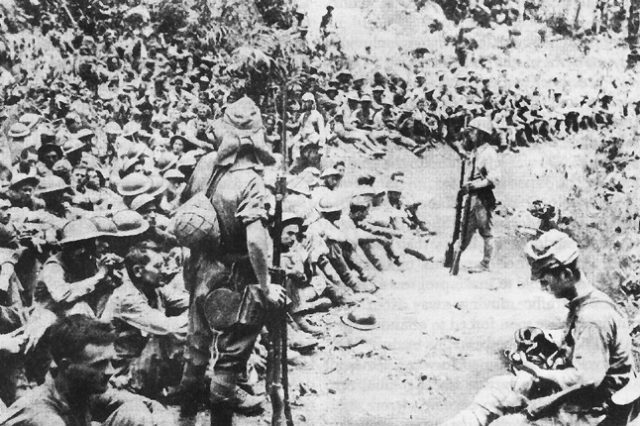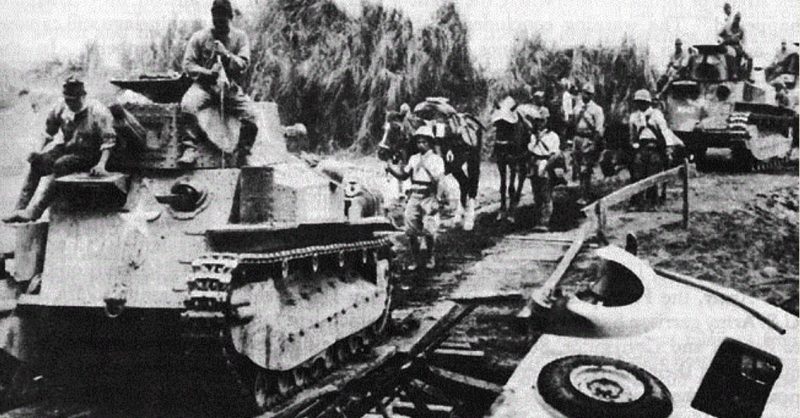The war in the Philippines started the day after Pearl Harbor was bombed and within a month the Imperial Japanese forces had captured Manila, and the American and Filipino forces were pushed back into the Bataan peninsula. For the following three months these forces fought a heroic rearguard action until eventually overcome by malaria, starvation, and lack of ammunition General Edward King Jr. surrendered with 75,000 troops. This surrender laid down the foundation for one of the most horrendous episodes of WWII, the Bataan Death March that claimed the lives of some 15,000 Filipino servicemen and 650 American soldiers.
When Col. Mootoo Nakayama of the 14th Japanese Army accepted General King’s surrender, the Japanese drove all their prisoners into the towns of Mariveles and Bagac. The Japanese were stunned by the number of prisoners, and they had absolutely no way to manage such a large number. There was no mechanized transport for such a large number, and there was no rail network on the Bataan peninsula but Col. Nakayama needed the prisoners out of the way so he could launch his final assault on the island of Corregidor.
The only option was to march the prisoners, most of whom were severely debilitated by malaria or starvation, to Camp O’Donnell, a Filipino training camp that was to be used as a prisoner of war camp. Before setting off on the march, all prisoners were made to stand in a large paddy field and turn out their pockets as they were not permitted personal items. The Japanese soldiers began collecting jewelry and other items. Japanese money and trinkets found on three prisoners were deemed to have been taken from dead Japanese soldiers so the men were summarily executed and word soon spread that any Japanese money had to be hidden otherwise the holder would be shot.

The Japanese herded their prisoners out from Mariveles on the 10th April 1941 and from Bagaz the following day. The march started off with brutality, which did not stop. The Japanese believed that men who surrendered were less than nothing and they treated their prisoners in that manner. The prisoners, most of whom were already weak from hunger and illness were treated with merciless brutality. Their meager possessions were stolen, and many had teeth with gold fillings knocked out for the gold content.
The first major atrocity of the march occurred when Colonel Masanobu Tsuji, ordered the execution of 350 – 400 Filipino officers, both commissioned and non-commissioned after they had surrendered near the River Pantangan. This went against his superior officer’s orders, but Colonel Tsuji ordered that his troops expeditiously execute all American captives.
Whilst marching, the prisoners were subject to all manner of abuse, and they received little in the way of food and water. One of the most common forms of punishment, meted out for the smallest infraction, was ‘sun treatment.’ In this, prisoners were forced to sit in the sun with no head protection, for hours on end. No food or water would be supplied, and anyone that asked for water would be executed. One story related by a prisoner revealed how when he tried to take a sip from his water canteen, a Japanese officer took it from him and poured the water into his horse’s nosebag, before throwing the canteen away. He then went on to take all the canteens that he could find and poured the water into the nosebag. When he had collected enough, he gave the water to his horse, leaving the prisoners with no water and no canteens.
Prisoners were not allowed to help each other, and those that collapsed were often run over by trucks, but those that collapsed due to fatigue were often picked up by the trucks at the end of the convoy. Not everyone who fell by the wayside was so lucky and many were shot or bayoneted to death where they lay on the road. Their bodies were simply left where they fell. The beatings and attacks with bayonets went on day after day.
When the prisoners reached Balanga, dysentery and other diseases common in places where people are overcrowded, and sanitation is poor, was rife. Medics from the prisoner’s ranks did their best to treat the ill, but they had few supplies and an untold number of patients. At the San Fernando rail head, the prisoners were forced into metal boxcars that quickly heated up to unbearable temperatures and temperatures hovering around 43̊ C were commonplace. 100 men at a time were shoe-horned into these metal boxes and disease and hunger continued to decimate the numbers of prisoners. Those that could no longer stand were wedged upright by the sheer numbers of men forced into each car. Sitting or lying down was impossible. Arriving at Capas gave little relief as they were then forced to walk the last nine miles to Camp O’Donnell.
Several hundred men died each day in the camp as they were so debilitated from the brutal treatment and the impossible march in merciless conditions. Most of the dead were buried in mass graves dug just outside the wire fence.
Three American officers managed to escape during the march and eventually in January 1944, news of the march and the unmitigated savagery meted out to the prisoners became public knowledge in America. Their story was featured in Life Magazine, and, unsurprisingly, it elicited a furious response from the people of the United States. The Japanese tried to blame the deaths of American officers who refused to surrender until their men were almost dead, so their deaths were not as a result of Japanese treatment, Business Insider Nordic reported.
This horrific episode in WWII history came to the attention of the Allied military commission at the end of the war, and it was declared a war crime. Several of the senior Japanese officers connected with this brutal march were sentenced to death and were either executed via firing squad or were hanged as a result.
It’s hard to imagine the conditions endured by these men. Notwithstanding the cultural differences, human beings have no right to treat one another with such cruelty. The barbarism of the Japanese forces would have lived with these men for the rest of their lives.
